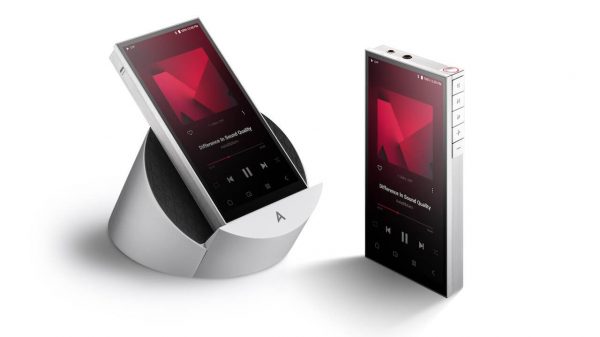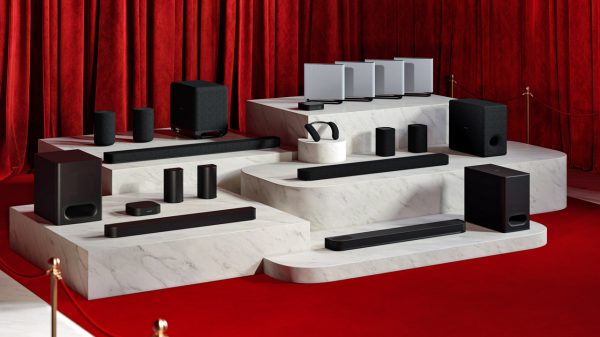Another soundbar review? You know it. There are so many manufacturers offering us soundbars right now we’ve had to turn some down in order to cover new AVRs and other home theater products. We were intrigued by this one and decided that it was too affordable to pass up. The Vizio M51ax-J6 is a 5.1 channel system that combines a soundbar, compact wireless subwoofer, and a set of surround speakers. Let’s take a look at what it offers that can improve your TV viewing experience.
Product Description
- The soundbar that comes with the M51ax-J6 system is 36-inches wide and houses the left, center, and right channel speakers.
- Each of the soundbar’s channels includes one 1.66″ x 3.48″ Full Range Driver and One 0.79″ Tweeter.
- The soundbar also houses two passive radiators that complement the full-range drivers in the lower frequencies for a fuller sound.
- The two compact surround speakers each house one 1.61” x 2.22” Full Range Driver.
- The subwoofer features a Bass Reflex ported design with one downward firing 5-inch Driver.
Connection and Control Options
The connections provided by the Vizio M51ax-J6 Soundbar include:

- 1 HDMI input (Dolby Atmos/DTS:X, 4K/60Hz video, Dolby Vision, and HDR10 pass-through).
- 1 HDMI output with ARC/eARC compatibility.
- 1 Digital optical audio input. (2-channel PCM, Dolby Digital and DTS 5.1 compatible)
- 2 Analog (3.5mm) audio inputs (one can be used to connect the audio output of a compatible Amazon Echo device).
- 1 USB Port – Supports .WAV and .MP3 music file playback from connected USB Flash Drives.
The Vizio M51ax-J6 5.1 comes with a remote control and limited touch controls on the top panel of the soundbar (Power, Input Select, Bluetooth Pairing, Volume). The soundbar is also compatible with many universal remotes and some TV remotes for access to basic functions (Volume, Mute, and Power).
Included Accessories
Here are all the additional things the Vizio M51ax-J6 comes with to get you started:
- Soundbar Power cable
- Subwoofer Power Cable
- Surround Speaker Audio Cables (2)
- Wall Mount Bracket Kit for Soundbar and Surround Speakers
- HDMI Cable
- User Manual
- Wall Mounting Template (Not visible – Under the User Manual)
- Cable Ties
- Remote Control with Batteries
- Digital Optical Cable
- Quick Setup Guide (not shown)

Set-Up
After unboxing the soundbar, subwoofer, and accessories, here is how to set up the system.
- Place the soundbar, surround speakers, and subwoofer where you want them (if you are wall-mounting the soundbar, the hardware is provided).
- Place the subwoofer where it delivers the best bass response. However, you also have to keep in mind that the surround speakers need to be connected to the subwoofer. This means that the length of the surround sound speaker cables may limit your subwoofer placement. The subwoofer houses the power source and the amplifier needed for the surround speakers to work. Since power is supplied by the subwoofer, the surround speakers don’t need to be connected to an AC power outlet.
- Place the surround speakers to the left and right side of the listening position slightly behind the listening position—about 90 to 110 degrees from the soundbar. You can also place the surround speakers in a “front surround” configuration where the surround speakers are placed in the front of the room on the left and right sides of the soundbar.
- Connect the provided HDMI cable from the soundbar to the HDMI-ARC/eARC port on your TV.
- (Optional) Connect a digital optical cable from the TV to the soundbar.
- (Optional) Connect a source device to the soundbars HDMI input, if you run out of HDMI connections on your TV.
- Plug the surround speakers into the subwoofer.
- Plug the soundbar and subwoofer into power using the provided cords.
- Turn the soundbar and subwoofer on and they should pair. The surround speakers become active once the subwoofer is paired.
- Put batteries in the remote and start using your system.
HDMI-ARC/eARC
For those that are not familiar with HDMI-ARC/eARC, here is a quick rundown.
HDMI-ARC and eARC transfer audio from your TV (including the audio from devices connected to your TV) to the soundbar. If using this connection you don’t need a separate digital optical or analog audio connection from the TV to the soundbar.

ARC will pass stereo, Dolby Digital, and DTS 5.1 audio. eARC additionally passes Dolby TrueHD, Atmos, DTS-HD Master Audio, or DTS:X.
For added convenience, the M51ax-J6 provides one HDMI input for connecting an external device, which provides a 4K video pass-through and access to the advanced surround formats mentioned above.
If you want to connect more than one HDMI source to the soundbar, you will need an HDMI switcher.
The Subwoofer
The subwoofer is very compact and is rated with a low-end response of 50Hz. However, upon testing I found that this small sub actually delivered strong bass output down to 45Hz with a significant drop below 40Hz. Not bad for a soundbar system.

When you plug the sub into power, it comes on and starts looking for the soundbar. If the soundbar can’t find the subwoofer it will provide an audible message “subwoofer not found”.
TIP: The subwoofer has a downward firing driver – make sure that nothing is protruding from the floor where you set it down.
Performance
The Vizio M51ax-J6 can easily fill a 15 x 20 foot room with two-channel sound for music or 5.1 channel sound for movies.
Although the Vizio M51ax-J6 5.1 has Dolby Atmos/DTS:X support, it relies on virtual sound processing (DTS Virtual:X) to execute the height channel effects.
When Virtual:X is activated, there is a definite expansion of the soundfield up and out, but if not adjusted, it can push the effect way too much to the surround speakers, making it sound like everything is right in front of you.

When the effect is adjusted (via the remote), the DTS Virtual:X processing does provide a more immersive listening environment, but I found that “overhead” sounds were not as precisely located as they would be with true Dolby Atmos/DTS:X execution supported by an overhead speaker setup.

When the M51ax-J6 is set up with the surround speakers placed in a Front Surround Mode configuration, the sound fills the front of the room and the DTS Virtual:X processing pushes sound towards the listening position from the front and slightly above, but the side and rear surround sound effect is diminished.

Another setup option is Dual Surround Mode. This uses the traditional 5.1 channel setup, but instead of sending specific surround signals to the surround speakers, the 51ax-J6 sends the same front left and right sound signal reproduced by the soundbar to the surround speakers. This results in more of a wide or whole room stereo mode, rather than a 5.1 channel surround mode. This works for both music than movies, but I preferred using it for music as it places the listener more within the music environment.
Audio Settings
In addition to Dolby Atmos/DTS:X decoding and DTS Virtual:X processing, the Vizio M51ax-J6 provides several audio settings that allow you to tailor the sound further.
There are four preset sound modes: Movie, Music, Direct, and Game.
Other settings include Bass, Treble, Dialog, Center, Subwoofer, Surround Level, Surround Balance, DTS TruVolume (Volume Leveling), DTS Virtual:X, and Night Mode (maintains bass output a low volume).
The audio processing needed for Dolby Audio, Atmos, or DTS is automatically engaged when those formats are detected.
The is also an Audio Delay feature that helps when the soundbar system’s audio is out of synch with your TV’s video.
Bluetooth
You can use Bluetooth to play music from compatible devices, such as smartphones, or connect an Amazon Echo device to access Alexa voice assistant features or play music from the echo device through the soundbar.
Alexa
Alexa is not built-in, but you can a connect compatible Alexa Echo device wired or wirelessly to the soundbar To get started, press Setup on the remote and go to Auto AV Setting.

Physical Connection Option: Connect the Echo device to the Aux AV input on the soundbar via a 3.5mm audio cable (requires purchase).
Bluetooth Connection Option: Press and hold the Bluetooth button on the sound bar or remote for three (3) seconds. Search for the sound bar (VIZIO M51) using your VA device app. For more information, refer to the user documentation that came with the device.
Once connected or paired, left/right buttons on the remote can be used to set the input to Aux/BT or Both to access your Alexa-enabled Echo Device.
If you are watching a TV program or movie you can ask Alexa a question. The soundbar will turn the soundbar volume down while Alexa answers your question. The sound will return to its previous level when Alexa is finished. You can also play music on the soundbar from any linked music streaming services on your connected Amazon Echo Dot or Echo Input.
NOTE: You can’t use Alexa to actually control the features of the Vizio M51ax-J6 5.1.

Final Thoughts
The low physical profile of the 36-inch wide soundbar fits under most TVs without blocking the bottom of the screen. If you have a wall-mounted TV, you can also wall-mount the soundbar, as well as the surround speakers (hardware is provided).
The Vizio M51ax-J6 5.1 works with any TV that has an analog stereo output, digital optical output, or HDMI-ARC/eARC connection.
The Vizio M51ax-J6 5.1 definitely improves the TV viewing experience delivering good bass, a clear midrange, and clean highs. Support for several surround sound formats is provided including Dolby Atmos and DTS:X, which is executed via DTS Virtual:X processing. Additional dialog enhancement, sound processing (including presets), and speaker setup options allow you to tailor your listening experience.
The Vizio M51ax-J6 5.1 provides surprisingly good performance for a modest price.
Pros
- Good overall stereo and surround sound.
- Front Surround and Dual-Mode setup options are available.
- Dolby Atmos/DTS:X compatibility.
- DTS Virtual:X processing provides an immersive soundfield.
- HDMI-ARC/eARC, digital optical, and analog audio inputs are provided.
- 4K HDR pass-through for HDMI-connected source devices.
- Easy Amazon Echo setup for accessing Alexa.
- Comes with all the cables and accessories to get started.
Cons
- Surround Speakers are not wireless.
- Default DTS Virtual:X setting pushes Dolby Atmos/DTS:X height effects too much to the surround speakers.
- Height sound effects immersive but not location precise.
- Inconvenient USB port location (rear of soundbar) – Suggest leaving a USB extension cable plugged in for easier access.
- No Apple Airplay 2 or Chromecast compatibility.
- No Wi-Fi connectivity.
Where to buy: $329 at Amazon | Best Buy







































Chris1983
September 27, 2021 at 9:07 pm
What would be the best method of connecting this to a display which doesn’t have an HDMI ARC input?
Ian White
September 27, 2021 at 9:44 pm
Chris,
If the TV has a Digital Optical or Analog RCA /3.5 mm audio output (Can be adapted to 3.5 mm AUX on the soundbar end) you can use those connection options. Digital Optical would be the next best if HDMI-ARC is not available.
Robert
robert
November 3, 2021 at 8:55 pm
Thank you for this very complete review. I do have a doubt, I am wondering if I could connect the video output from a Laptop to this soundbar using the HDMI in, then pass the video from the soundbar to a pc monitor? If it’s doable I’m worried that the passthrough would support higher resolutions, such as full HD or above…
Ian White
November 4, 2021 at 12:40 am
Robert,
You should be able to connect the HDMI output from the Laptop to the HDMI input on Vizio and then connect the HDMI output of the laptop to the PC monitor – The only problem that may occur is whether both the Laptop and Monitor you are using are HDCP (High Bandwith Digital Content Protecton) -enabled – if not you may encounter and HDMI handshake issue where the HDMI connection between all three devices is not recognized (blank screen or non-supported image message). If successful, whatever the video resolution of your Laptop video output is would be passed through the soundbar to your PC monitor.
If that setup fails, your alternative would be to connect the laptop to the PC monitor directly via HDMI and if your Laptop has a digital optical (Toslink) audio output or analog audio output to the soundbar. However, you would not be able to access Dolby Atmos as that can only be sent via HDMI – however, the digital output would be able to transfer standard Dolby Digital and the analog audio connection would be able to transfer 2-channel PCM stereo.
Robert Silva
Jay
January 5, 2022 at 5:33 am
How is it holding up? Do you find yourself with connection issues? Lag?